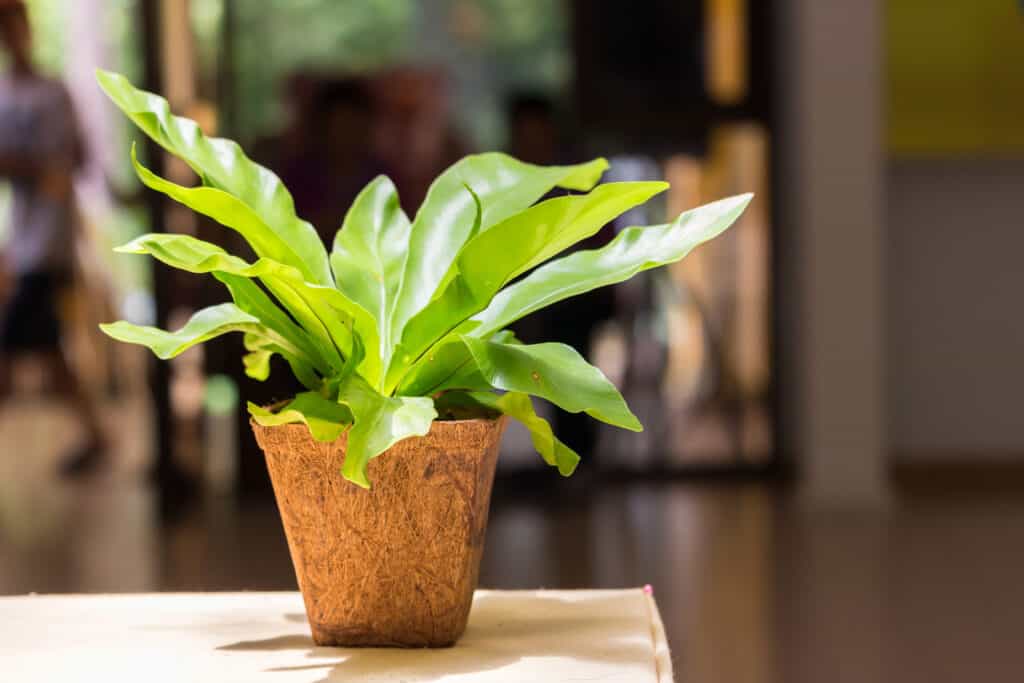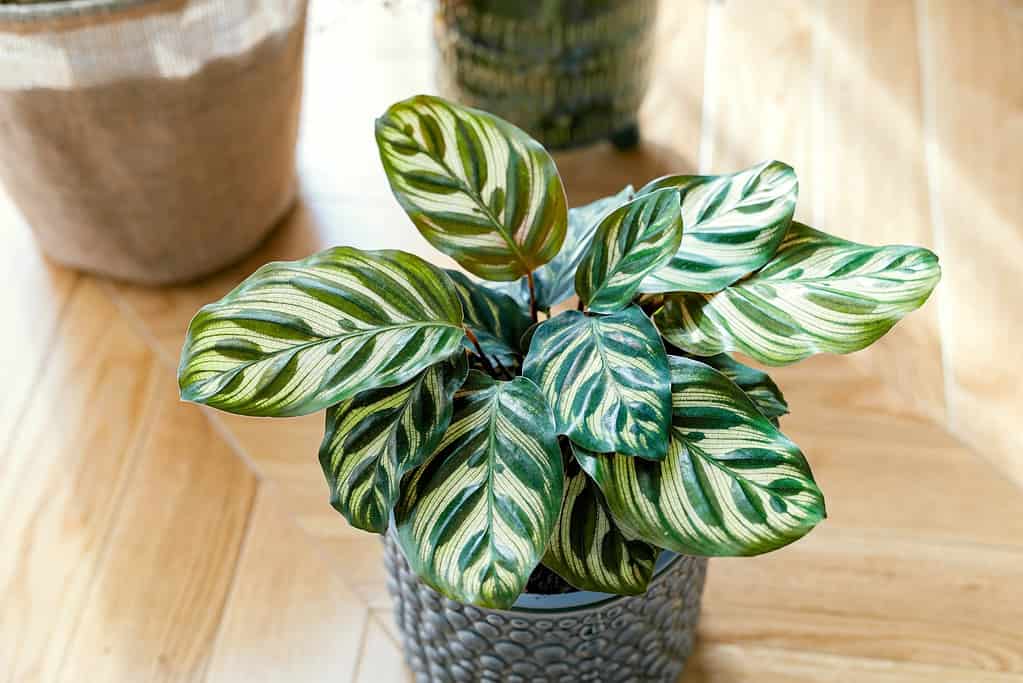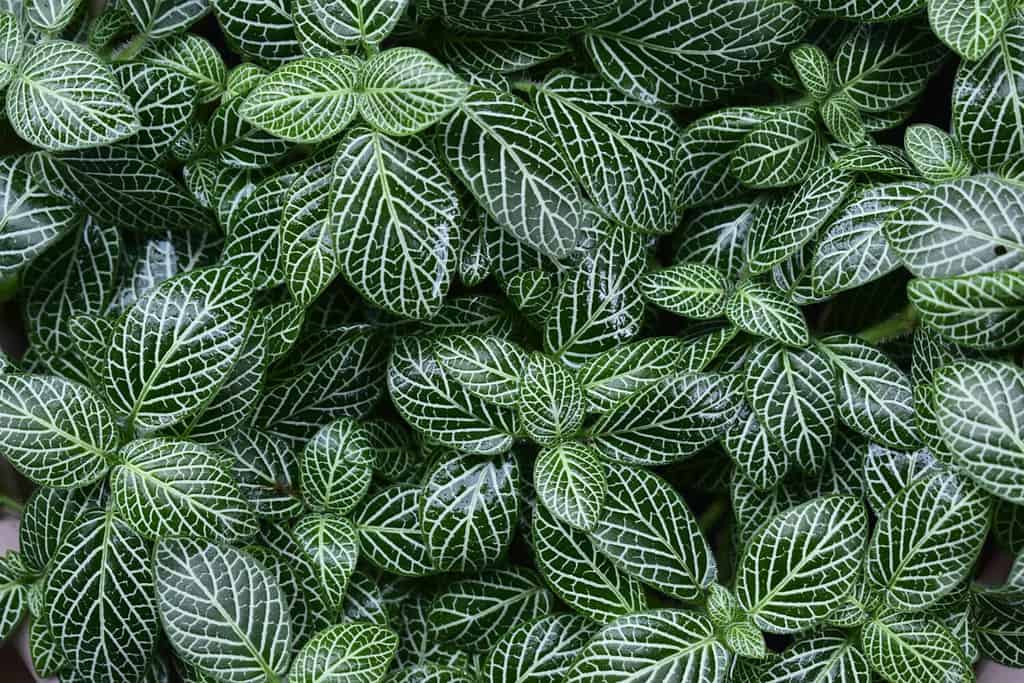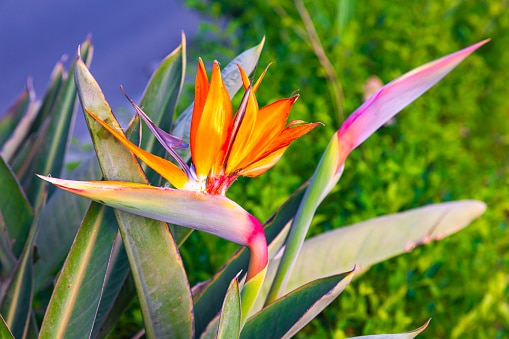Step into the lush world of houseplants, where greenery thrives in the cozy embrace of humidity. If you’ve ever wondered which plants will flourish in the muggy haven of your home, you’re in the right place. Humidity isn’t just a weather thing; it’s also a secret weapon for nurturing vibrant indoor gardens.
In this article, we’ll explore a curated selection of houseplants that adore the moist atmosphere of your abode. Forget the constant struggle of watering and re-watering. These humid home houseplants revel in the moisture, making them a breeze to care for!
1. Ferns

Most species and varieties of ferns generally need water every one to two weeks.
©Toey Toey/Shutterstock.com
Ferns are excellent choices for indoor plants in homes with high humidity levels. They thrive in such conditions because they have evolved to adapt to moist environments, which makes them resilient and attractive additions to indoor spaces. Several fern species are great humid home houseplants, each offering unique visual appeal.
One popular choice is the Boston Fern (Nephrolepis exaltata). This fern features delicate, feathery fronds that arch gracefully, creating a lush, green canopy. Its bright green foliage adds a touch of vibrancy to any room. Another option is the Maidenhair Fern (Adiantum spp.), known for its dainty, fan-shaped leaflets that appear on wiry stems. The delicate appearance of Maidenhair Ferns contrasts beautifully with their robust growth in humid conditions.
If you prefer a compact fern, the Bird’s Nest Fern (Asplenium nidus) is an excellent choice. Its wavy, glossy fronds emerge from a central rosette, resembling a bird’s nest, hence the name. These ferns are relatively easy to care for and can tolerate lower light levels.
For those seeking a more dramatic statement, the Staghorn Fern (Platycerium spp.) is an intriguing choice. It exhibits distinctive antler-shaped fronds that can grow quite large, resembling the antlers of a stag. Mounted on a wooden board, the Staghorn Fern creates an eye-catching living art piece.
All fern varieties share the common trait of being well-suited to high-humidity environments, regardless of the specific variety. In homes with adequate moisture, ferns thrive by efficiently absorbing moisture through their fronds. Their lush green foliage not only enhances indoor air quality by removing pollutants but also brings a touch of nature’s beauty indoors.
2. Orchids

The orchid family is
the largest current family
of flowering houseplants.
©Kororirori/Shutterstock.com
Orchids are excellent choices for indoor plants, especially in homes with elevated humidity levels. People know these graceful and exotic plants for their ability to thrive in humid environments, making them an ideal addition to your indoor garden. Several orchid varieties do exceptionally well in such conditions, each offering unique and captivating appearances.
One popular orchid species for indoor cultivation is the Phalaenopsis orchid, often referred to as the “Moth Orchid.” These orchids have large, flat blossoms with striking colors and patterns, which they are well-known for. Phalaenopsis orchids can display a range of hues, from classic white and pink to vibrant purples and yellows. They have a timeless elegance that can complement any interior decor.
Another remarkable option is the Dendrobium orchid, known for its tall, slender canes adorned with clusters of vibrant, tubular flowers. These orchids come in various colors, such as purple, pink, and white, creating a visually stunning display. Dendrobiums thrive in the right humidity, rewarding you with beautiful blooms.
The Oncidium orchid, or “Dancing Lady” orchid, is a unique choice with cascading sprays of petite, intricately shaped flowers that resemble dancing figures. These orchids have a charming and distinct appearance, making them a favorite among orchid enthusiasts. They perform exceptionally well in humid indoor environments.
Orchids, in general, are well-suited to high-humidity homes. Their elegant and exotic aesthetics make them stand out as houseplants, bringing a touch of the tropics into your living space. Orchids are known for their air-purifying properties in addition to their visual appeal, enhancing indoor air quality.
3. Calathea

Calathea houseplants are known for their wide, supple leaves and ease of care. They also require little sunlight.
©Damian Lugowski/iStock via Getty Images
Calathea plants are an excellent choice for indoor gardening, particularly in homes with high humidity levels. These stunning tropical plants are renowned for their striking foliage and their ability to thrive in humid environments. Several Calathea varieties flourish indoors, each offering unique and captivating appearances.
One popular Calathea species is the Calathea ornata, also known as the “Pinstripe Plant.” It features glossy, dark green leaves with contrasting pink or white stripes, resembling delicate brush strokes. The Pinstripe Plant’s visually striking foliage makes it a sought-after choice for adding a touch of elegance to your indoor space.
The Calathea medallion (Calathea roseopicta) is another remarkable option. Its leaves are adorned with intricate patterns that resemble artistic brushwork. The vibrant green leaves are often highlighted with shades of pink, burgundy, or silver, creating a mesmerizing display of color and texture.
Calathea zebrina, commonly referred to as the “Zebra Plant,” boasts unique, elongated leaves with bold zebra-like stripes. These stripes alternate between deep green and lighter shades, making the Zebra Plant an eye-catching addition to any room. Its distinct appearance adds a touch of the wild to your indoor oasis.
Calathea plants thrive in humid environments, mimicking their native tropical habitats. Their lush, vibrant foliage is well-suited to homes with elevated moisture levels. In addition to their aesthetic appeal, Calathea plants also contribute to improved indoor air quality by purifying the air, making them both beautiful and functional houseplants.
4. Philodendrons

All philodendron species and varieties contain calcium oxalate crystals, making them toxic to humans and pets.
©Elzloy/Shutterstock.com
Philodendrons are versatile and well-suited houseplants, particularly in homes with elevated humidity levels. These lush, tropical plants thrive in moist environments and come in various captivating varieties, making them popular choices for indoor gardening.
One widely recognized philodendron species is the Heartleaf Philodendron (Philodendron hederaceum). It features heart-shaped, glossy leaves that cascade gracefully, creating a charming green curtain. The Heartleaf Philodendron’s simplicity and ease of care make it an ideal humid home houseplant.
Another attractive option is the Split-Leaf Philodendron (Philodendron bipinnatifidum), also known as the Swiss Cheese Plant. This philodendron boasts large, deeply lobed leaves with unique perforations, resembling Swiss cheese. Its dramatic foliage adds a touch of tropical flair to indoor spaces.
The Philodendron Brasil (Philodendron hederaceum ‘Brasil’) is distinguished by its striking variegated leaves, featuring bright green centers with yellow stripes. This eye-catching combination of colors adds vibrancy and visual interest to your home.
Philodendrons thrive in high-humidity homes because they originate from tropical rainforests where moisture levels are abundant. Their adaptability to such conditions allows them to thrive indoors with minimal effort. Additionally, philodendrons are excellent air purifiers, contributing to healthier indoor air quality.
5. Spider Plants

The ever-popular spider plant is a low-maintenance plant that only needs to be watered about once per week, but it does best in homes with a lot of humidity.
©IZZ HAZEL/Shutterstock.com
Spider plants are excellent choices for indoor gardening, especially in homes with elevated humidity levels. These hardy and adaptable houseplants thrive in moist conditions, making them ideal for those seeking low-maintenance greenery. There are several varieties of spider plants, each with distinct features that add a touch of natural beauty to your home.
The most common variety is the Spider Plant (Chlorophytum comosum ‘Vittatum’). It boasts arching, narrow leaves that are green with white stripes, creating a striking contrast. The leaves grow in a rosette shape and can reach up to two feet in length, making it an attractive focal point in any room.
For those looking for a bit of variation, the Spider Plant ‘Bonnie’ (Chlorophytum comosum ‘Bonnie’) is a captivating choice. Its leaves are shorter and broader than the standard variety, and they feature a distinctive curling pattern at the tips, giving it an elegant and unique appearance.
Another intriguing option is the Spider Plant ‘Zebra Grass’ (Chlorophytum comosum ‘Zebra’). As the name suggests, it has leaves with zebra-like stripes that add a touch of exotic flair to your indoor space. The variegated foliage makes it a standout addition to your plant collection.
Spider plants are well-suited to high-humidity homes due to their natural resilience and adaptability. They are proficient at absorbing excess moisture from the air, which can be particularly beneficial in humid environments. Additionally, spider plants are renowned for their air-purifying properties, making them an excellent choice for improving indoor air quality.
6. Fittonia

These unique Fittonia plants are known as nerve plants due to the unique patterns on their leaves that resemble nerves.
©Evade Mster/Shutterstock.com
Fittonia plants, commonly known as “nerve plants,” are excellent choices for indoor gardening, especially in homes with elevated humidity levels. These vibrant, low-growing plants are native to tropical rainforests and have adapted well to the humid conditions found in many homes. Fittonia comes in various species and varieties, each with its unique appearance.
One of the most popular Fittonia varieties is Fittonia albivenis. This species features striking foliage with intricate patterns of white or pink veins that contrast beautifully against the lush green leaves. The delicate veining gives the plant its common name, “nerve plant,” and adds a touch of elegance to any indoor setting.
Fittonia verschaffeltii is another captivating choice. It is known for its compact growth habit and bold, dark green leaves adorned with vibrant red or pink veins. This variety creates a striking visual contrast that can make a bold statement in your home decor.
Fittonia argyroneura, or the “Silver Nerve Plant,” is distinguished by its silver-gray veining that stands out against the deep green foliage. The silvery veins create a subtle shimmering effect, making this variety a unique and eye-catching addition to your indoor garden.
Fittonia plants are well-suited to high-humidity homes due to their natural habitat in tropical rainforests. They have evolved to thrive in environments with ample moisture, making them resilient houseplants for indoor settings with increased humidity levels. Additionally, Fittonias are relatively easy to care for, making them an ideal choice for both novice and experienced plant enthusiasts.
7. Bird of Paradise

All species of
Bird of Paradise
plants are popular houseplants for homes in very humid climates.
©Sergii Zhmurchak/iStock via Getty Images
Bird of Paradise plants thrive as striking houseplants in homes with elevated humidity levels. These tropical beauties are known for their bold foliage and adaptability to humid indoor environments. Several Strelitzia species and varieties offer unique visual appeal, making them popular choices for indoor gardening.
The most well-known Bird of Paradise variety is Strelitzia reginae, also called the “Orange Bird of Paradise.” Its distinctive, banana-like leaves unfurl in a fan-like fashion, showcasing glossy green foliage with vibrant orange and blue accents. This iconic plant can grow quite large, making it a dramatic statement piece in any room.
Strelitzia nicolai, or the “Giant Bird of Paradise,” is another impressive choice. It features even larger, paddle-shaped leaves that can reach up to 5 feet in length. The leaves are deep green, and the plant can grow into a striking, tree-like specimen. Its majestic presence adds a touch of the exotic to your indoor space.
For those seeking a more compact option, the Strelitzia juncea, or “Narrow-Leaf Bird of Paradise,” is a captivating choice. Its slender, reed-like leaves are arranged in a fan shape, and they lack the broad leaf blade typical of other Bird of Paradise varieties. The unique appearance of the Narrow-Leaf Bird of Paradise offers a modern and minimalistic aesthetic.
Bird of Paradise plants thrive in humid conditions, replicating their native tropical habitat. Their lush, broad leaves efficiently absorb moisture from the air, making them well-suited for homes with increased humidity. Additionally, Bird of Paradise plants not only elevate indoor air quality but also create an inviting tropical ambiance.
8. Bromeliads

Bromeliad blooms last for a very long time, usually around six months if they are properly cared for and given the proper amount of sunlight.
©iStock.com/ASIMAKIN
Bromeliads are exceptional choices for indoor plants, especially in homes with elevated humidity levels. These unique and vibrant plants have adapted well to the moist conditions often found indoors. There is a wide variety of bromeliad species, each offering its distinctive appearance and charm.
One of the most popular bromeliad species is the Guzmania bromeliad. It features a central rosette of long, slender leaves in shades of green or red, often adorned with colorful bracts that resemble flowers. These bracts can be brilliant red, yellow, or orange, creating a striking contrast against the green foliage. Guzmania bromeliads are known for their stunning and long-lasting displays.
Another captivating bromeliad is the Neoregalia, which boasts an impressive array of colors and patterns. Its leaves form a central cup, creating a reservoir for water. Neoregalia bromeliads come in various shades, from vibrant reds to deep purples, and feature intricate striping or mottling patterns that add to their visual appeal.
The Aechmea bromeliad is another eye-catching choice. It features arching, strap-like leaves that form a rosette, and its inflorescence emerges from the center, often bearing vibrant pink or red bracts. Aechmea bromeliads add a touch of tropical elegance to indoor spaces.
Bromeliads are well-suited to high-humidity homes because they naturally thrive in tropical environments where moisture is abundant. Their unique rosette-shaped foliage efficiently captures moisture, making them resilient houseplants. Additionally, bromeliads are low-maintenance and require minimal care, making them suitable for both beginners and experienced plant enthusiasts.
Summary of the Best Indoor Houseplants for Humid Homes
| # | Houseplant | Sunlight Needs |
|---|---|---|
| 1 | Ferns | Indirect filtered light |
| 2 | Orchids | Bright indirect light |
| 3 | Calathea | Low to moderate indirect light |
| 4 | Philodendrons | Low to moderate indirect light |
| 5 | Spider Plants | Bright, indirect light |
| 6 | Fittonia | Low to moderate indirect light |
| 7 | Bird of Paradise | Bright, indirect light to some direct light |
| 8 | Bromeliads | Bright, indirect light |
The photo featured at the top of this post is © Rorygez Fresh/Shutterstock.com
Thank you for reading! Have some feedback for us? Contact the AZ Animals editorial team.







